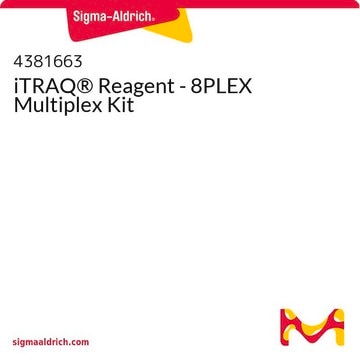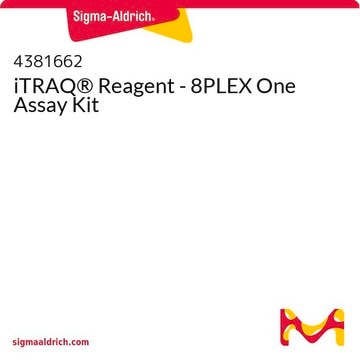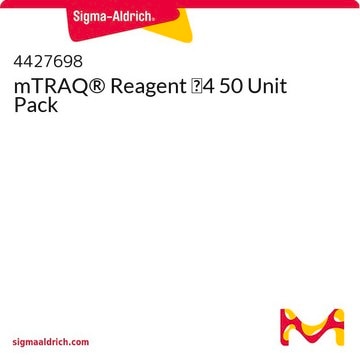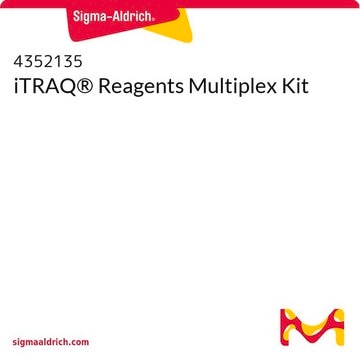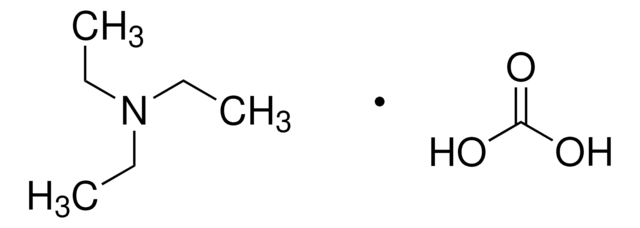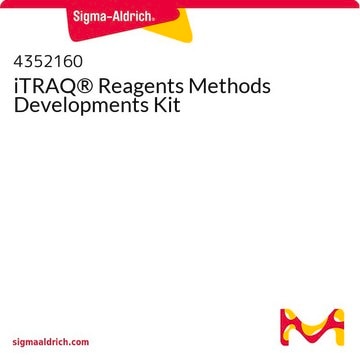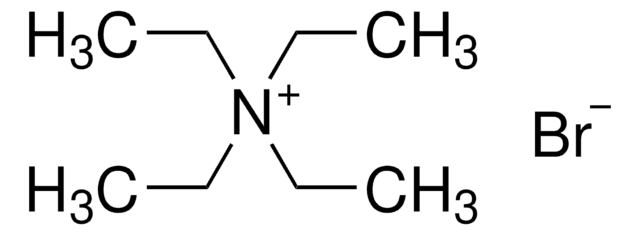4381664
iTRAQ® Reagent - Multiplex Buffer Kit
Synonym(s):
isobaric tags for relative and absolute quantitation, buffer kit
Sign Into View Organizational & Contract Pricing
All Photos(1)
About This Item
UNSPSC Code:
12161503
NACRES:
NA.25
Recommended Products
shipped in
dry ice
storage temp.
−20°C
General description
Contains SDS – Denaturant, TCEP Reducing Reagent, MMTS Cysteine Blocking Reagent, TEAB Buffer and Isopropanol, sufficient material for either two 8-plex Multiplex Kits, three 4-plex Kits, or four mTRAQ® 10 Assay Kits.
The iTRAQ® Reagents are a set of isobaric, multiplexed, amine-specific, stable-isotope reagents that can label all peptides in up to eight different biological samples at the same time, allowing for simultaneous identification and quantitation, both relative and absolute, while preserving important post-translational modification (PTM) information. The iTRAQ® reagents can be used to study the differential expression of proteins in perturbed systems.
Application
iTRAQ® Reagent - Multiplex Buffer Kit has been used in the isobaric tag for relative and absolute quantitation (iTRAQ) labeling of protein samples.
Analysis Note
To view the Chemistry Quick Reference Card for the iTRAQ® Reagents, please visit this Chemistry Quick Reference Card link.
Legal Information
MTraq is a registered trademark of AB Sciex Pte. Ltd.
iTraq is a registered trademark of AB Sciex Pte. Ltd.
signalword
Danger
hcodes
Hazard Classifications
Eye Irrit. 2 - Flam. Liq. 2 - Skin Irrit. 2 - STOT SE 3
target_organs
Central nervous system
wgk_germany
WGK 3
flash_point_f
53.6 °F
flash_point_c
12.0 °C
Certificates of Analysis (COA)
Search for Certificates of Analysis (COA) by entering the products Lot/Batch Number. Lot and Batch Numbers can be found on a product’s label following the words ‘Lot’ or ‘Batch’.
Already Own This Product?
Find documentation for the products that you have recently purchased in the Document Library.
Customers Also Viewed
Lynn R Zieske
Journal of experimental botany, 57(7), 1501-1508 (2006-04-01)
Proteomic research includes the characterization of protein mixtures in order to understand complex biological systems and determine relationships between proteins, their function, and protein-protein interactions. Often the goal of such research is to monitor changes of proteins in perturbed systems
Hongmei Lu et al.
Clinical proteomics, 16, 33-33 (2019-08-07)
Diabetic nephropathy is the most frequent cause of end-stage renal disease worldwide. Identification of biomarkers for diabetic nephropathy for early diagnosis may be the key to avoiding damage from this condition. Proteomic iTRAQ technology was first used to identify differentially
Our team of scientists has experience in all areas of research including Life Science, Material Science, Chemical Synthesis, Chromatography, Analytical and many others.
Contact Technical Service